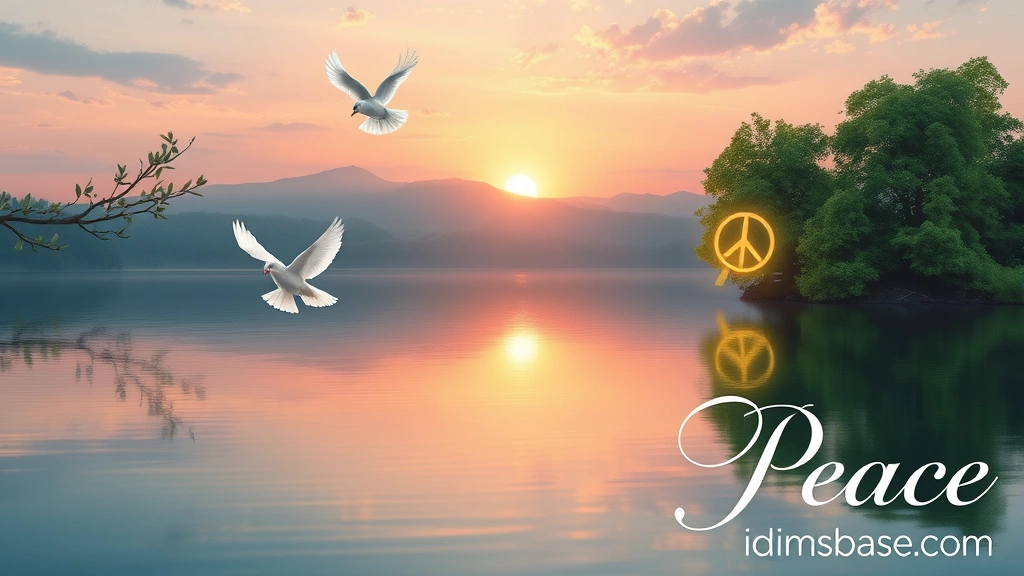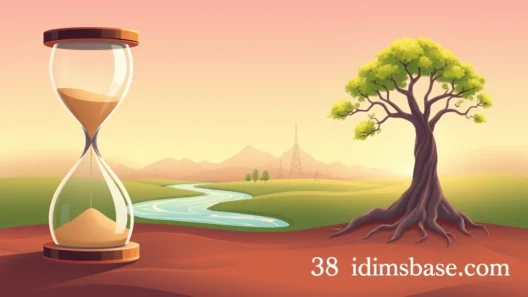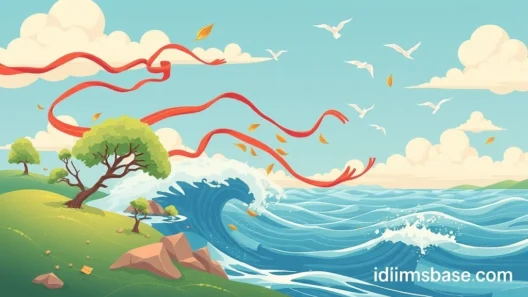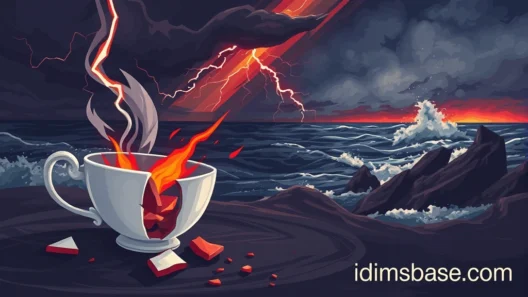Are you ready to explore the beautiful concept of peace in a whole new light? Peace, in its purest form, is more than just the absence of conflict; it's a profound state of being, a feeling, a journey, and a destination all rolled into one. It’s something we all yearn for, whether in our personal lives, our communities, or on a global scale. But how do we truly describe something so vast and multifaceted?
That's where metaphors come in! Metaphors are like little magic wands for our language, allowing us to paint vivid pictures and understand complex ideas by comparing them to something simpler or more familiar. They help us connect with concepts on a deeper, more emotional level. So, let’s embark on a delightful journey to uncover 38 powerful metaphors that beautifully illustrate the essence of peace. Get ready to see peace through a fresh, imaginative lens!
38 Metaphors for Peace
Let's dive into these incredible comparisons that bring the idea of peace to life. Each one offers a unique perspective, helping you grasp the many facets of this cherished state.
- Peace is a Calm Ocean: Imagine a vast expanse of water, smooth as glass, reflecting the sky. No turbulent waves, no crashing storms, just serene stillness. That’s peace.
- Peace is a Gentle Breeze: It’s that soft, comforting whisper of air that cools your skin on a warm day, bringing tranquility and lightness.
- Peace is a Quiet Meadow: A lush, green space, untouched by noise or disturbance, where wildflowers bloom and the only sounds are nature's soft hum.
- Peace is a Warm Embrace: The feeling of being held securely, loved, and safe, where all worries melt away in comforting warmth.
- Peace is a Still Pond: Reflecting the world around it with perfect clarity, undisturbed and unruffled, offering a mirror to the soul.
- Peace is a Soft Blanket: Wrapping you in comfort and security, shielding you from the harshness of the world outside.
- Peace is a Melody Without Discord: A harmonious tune where every note blends perfectly, creating a beautiful, soothing sound.
- Peace is a Lighthouse: Guiding ships safely through stormy seas, offering a beacon of hope and stability in chaos.
- Peace is a Deep Breath: The act of inhaling calm and exhaling tension, a simple yet profound way to recenter yourself.
- Peace is a Clear Sky: Limitless, unclouded, and full of possibility, offering a sense of openness and freedom.
- Peace is a Rooted Tree: Standing firm and unyielding against the winds of change, drawing strength from deep within the earth.
- Peace is a Sanctuary: A sacred space where you feel completely safe, protected, and at ease, free from judgment or threat.
- Peace is a Gentle Rain: Softly nourishing the earth, washing away dust and grime, leaving freshness and renewal in its wake.
- Peace is a Balanced Scale: Where justice and harmony weigh equally, ensuring fairness and equilibrium.
- Peace is a Mended Tear: When something broken is carefully repaired, leaving it whole and strong once more.
- Peace is a Healing Balm: Soothing wounds, easing pain, and promoting recovery, both physically and emotionally.
- Peace is a Golden Sunset: A moment of breathtaking beauty and tranquility as the day gently fades into night.
- Peace is a Whispering Library: Quiet, respectful, and filled with knowledge, where thoughts can flourish undisturbed.
- Peace is an Open Door: Inviting understanding, connection, and new beginnings, rather than closing off possibilities.
- Peace is a Steady Flame: Not flickering wildly, but burning consistently and brightly, providing warmth and light.
- Peace is a Shared Smile: A simple, universal gesture of goodwill that connects people across all divides.
- Peace is a Grounded Anchor: Holding you firm and stable, preventing you from drifting away in turbulent times.
- Peace is a Clear Stream: Flowing effortlessly, purifying itself as it moves, always fresh and life-giving.
- Peace is a Silent Promise: A commitment to non-violence and understanding, often unspoken but deeply felt.
- Peace is a Gentle Handshake: A gesture of respect, reconciliation, and mutual agreement.
- Peace is a Soft Landing: After a long journey or a difficult fall, a moment of gentle arrival and relief.
- Peace is a Blooming Flower: Unfolding naturally, beautifully, and without force, revealing its true essence.
- Peace is a Woven Tapestry: Many different threads, colors, and textures coming together to form a beautiful, cohesive whole.
- Peace is a Shared Meal: Breaking bread together, fostering connection, and building bridges over common ground.
- Peace is a Guiding Star: Offering direction and hope, especially when you feel lost or uncertain.
- Peace is a Reset Button: The chance to clear the slate, let go of the past, and start fresh with a new perspective.
- Peace is a Purring Cat: A symbol of contentment, comfort, and quiet satisfaction.
- Peace is a Calm Harbor: Where ships find refuge from storms, a place of safety and rest.
- Peace is a Seed of Hope: Small yet powerful, containing the potential for growth, healing, and a brighter future.
- Peace is a Listening Ear: The act of truly hearing and understanding another, fostering empathy and connection.
- Peace is a Feather: Light, delicate, and floating, representing a release from burdens and worries.
- Peace is a Balanced Ecosystem: Where every element works in harmony, supporting and sustaining the whole.
- Peace is a Sunrise: A new beginning, fresh light, and the promise of a beautiful day unfolding.
Key Takeaways
Wow, that was quite a journey, wasn't it? We’ve seen how peace can be described in so many wonderful and imaginative ways. Here are some key insights to remember:
- Peace is Multidimensional: It’s not just one thing, but a vast concept encompassing tranquility, harmony, safety, and well-being.
- Metaphors Deepen Understanding: Using comparisons helps us connect with abstract ideas like peace on a more intuitive and emotional level.
- Peace is Both Internal and External: Many metaphors highlight personal serenity (like a "deep breath" or "warm embrace"), while others point to societal harmony (like a "balanced scale" or "woven tapestry").
- Peace is Active and Passive: It can be a state of being (a "calm ocean") or something we actively cultivate (a "mended tear" or "shared smile").
- Peace is Universal: Despite its many forms, the longing for peace is a shared human experience across cultures and borders.
Frequently Asked Questions (FAQ)

You might have some questions lingering in your mind about metaphors and peace. Let’s tackle some common ones!
What is a metaphor, really?
A metaphor is a figure of speech that directly compares two unlike things without using "like" or "as." It states that one thing is another, even though it's not literally true. For example, when we say "Peace is a calm ocean," we don't mean peace is literally a body of water, but rather that it shares the qualities of a calm ocean – stillness, vastness, and serenity. It helps us understand complex ideas by relating them to something more concrete or familiar.
Why are metaphors important for understanding peace?

Metaphors are incredibly powerful because they allow us to grasp abstract concepts like peace more vividly. Peace isn't something you can touch or see directly, but when we compare it to a "warm embrace" or a "quiet meadow," we can feel what peace is like. They bypass purely logical thinking and tap into our emotions and imagination, making the concept more relatable and memorable. They help us communicate the nuances of peace in a way that plain language might not.
Can metaphors help us achieve peace?
While metaphors themselves don't directly create peace, they play a crucial role in how we perceive and discuss peace. By using metaphors, we can:
- Inspire Hope: Metaphors like "peace is a sunrise" or "a seed of hope" can inspire us to believe in the possibility of peace, even in challenging times.
- Foster Empathy: When we describe peace as a "shared meal" or a "listening ear," it highlights the relational aspects of peace, encouraging understanding and connection.
- Guide Action: If peace is a "mended tear," it suggests active work towards reconciliation. If it's a "balanced scale," it points towards justice. Metaphors can implicitly guide our efforts.
- Create Shared Vision: When a community or nation adopts a common metaphor for peace, it can help them work together towards a unified goal.

So, yes, by shaping our understanding and vision, metaphors can certainly contribute to the journey towards achieving peace.
Are there different types of peace, and do metaphors reflect this?
Absolutely! Peace isn't a monolithic concept. We often talk about:
- Inner Peace: This refers to a state of mental and spiritual calm, free from disturbance. Metaphors like "a deep breath," "a still pond," or "a purring cat" often describe inner peace.
- Interpersonal Peace: This is about harmony and understanding between individuals. "A shared smile," "a gentle handshake," or "a listening ear" are great examples.
- Social/Community Peace: This involves harmony within groups, neighborhoods, or nations, characterized by justice and lack of conflict. Metaphors like "a balanced ecosystem" or "a woven tapestry" fit here.
- Global Peace: This is the absence of war and conflict on a worldwide scale. Metaphors such as "a calm ocean" or "a clear sky" can evoke this grand scale.
The beauty of these 38 metaphors is that they touch upon all these different facets, showing just how rich and varied the concept of peace truly is.
How can I use these metaphors in my daily life?
Using these metaphors can enrich your language and deepen your appreciation for peace!
- In Conversation: When discussing peace with friends or family, try using one of these metaphors to explain your feelings or ideas. "I'm looking for a little more 'quiet meadow' in my life right now."
- For Reflection: When you feel stressed, think of "peace as a deep breath" and consciously take one. Or imagine "peace as a calm ocean" to visualize tranquility.
- In Writing or Art: If you're a writer, poet, or artist, let these metaphors inspire your creative work about peace.
- As a Goal: If "peace is a lighthouse," how can you be a beacon of stability for others? If it's a "reset button," how can you apply that to your own challenges?
Embracing these metaphors can make peace feel more tangible and attainable in your everyday existence.
We hope this exploration of metaphors for peace has brought a sense of calm and inspiration to your day. Remember, peace is a journey, not just a destination, and understanding its many facets is the first step towards cultivating it in our lives and in the world around us. Which metaphor resonated most with you? We’d love to hear your thoughts!






